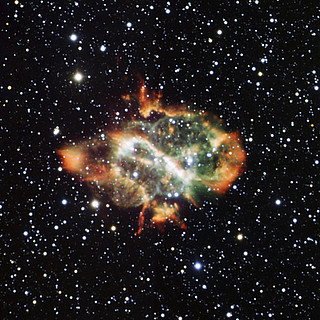by bystander » Wed Mar 24, 2010 1:51 pm
NGC5189: Dying Star Puffs a Cosmic Dragon
ESO Picture of the Week - 2010 March 22

NGC 5189 is a planetary nebula with an oriental twist. Similar in appearance to a Chinese dragon, these red and green cosmic fireworks are the last swansong of a dying star.
At the end of its life, a star with a mass less than eight times that of the Sun will blow its outer layers away, giving rise to a planetary nebula. Some of these stellar puffballs are almost round, resembling huge soap bubbles or giant planets (hence the name), but others, such as NGC 5189 are more intricate.
In particular, this planetary nebula exhibits a curious “S”-shaped profile, with a central bar that is most likely the projection of an inner ring of gas discharged by the star, seen edge on. The details of the physical processes producing such a complex symmetry from a simple, spherical star are still the object of astronomical controversy. One possibility is that the star has a very close (but unseen) companion. Over time the orbits drift due to precession and this could result in the complex curves on the opposite sides of the star visible in this image.
This image has been taken with the New Technology Telescope at ESO’s La Silla Observatory in Chile, using the now decommissioned EMMI instrument. It is a combination of exposures taken through different narrowband filters, each designed to catch only the light coming from the glow of a given chemical element, namely hydrogen, oxygen and nitrogen.
[url=http://www.eso.org/public/images/potw1012a/]NGC5189: Dying Star Puffs a Cosmic Dragon[/url]
ESO Picture of the Week - 2010 March 22
[url=http://www.eso.org/public/archives/images/large/potw1012a.jpg][img]http://www.eso.org/public/archives/images/medium/potw1012a.jpg[/img][/url]
[quote]NGC 5189 is a planetary nebula with an oriental twist. Similar in appearance to a Chinese dragon, these red and green cosmic fireworks are the last swansong of a dying star.
At the end of its life, a star with a mass less than eight times that of the Sun will blow its outer layers away, giving rise to a planetary nebula. Some of these stellar puffballs are almost round, resembling huge soap bubbles or giant planets (hence the name), but others, such as NGC 5189 are more intricate.
In particular, this planetary nebula exhibits a curious “S”-shaped profile, with a central bar that is most likely the projection of an inner ring of gas discharged by the star, seen edge on. The details of the physical processes producing such a complex symmetry from a simple, spherical star are still the object of astronomical controversy. One possibility is that the star has a very close (but unseen) companion. Over time the orbits drift due to precession and this could result in the complex curves on the opposite sides of the star visible in this image.
This image has been taken with the New Technology Telescope at ESO’s La Silla Observatory in Chile, using the now decommissioned EMMI instrument. It is a combination of exposures taken through different narrowband filters, each designed to catch only the light coming from the glow of a given chemical element, namely hydrogen, oxygen and nitrogen.[/quote]